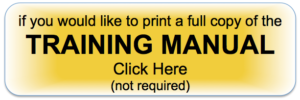EWP 11m+ Boom Licensing Course
Trainee Workbook
You are about to embark on training for the safe operations of an ELEVATING WORK PLATFORM.
PLEASE NOTE: during some videos we will refer to “forklift licence” … don’t worry about this.
The information is the same for both classes of licence and therefore the same video will show.

General introduction to all HRW licence training.
This trainee workbook is about the skills and knowledge required to operate an EWP, including checking EWP condition, operational requirements, monitoring site conditions, and monitoring and maintaining EWP performance.
The Training Manual & Practice Questions on the link below are your Training Materials.
There are Videos coincide with your Training Materials to help prepare you for your practical Training as well as your written Assessment which you will complete at a date to be determined after your Face-to-Face training.
The beauty about our Training Material is that it allows you to re-read or re-watch something that you didn’t fully understand the first time. You will then have opportunity to refresh everything at your Face-to-Face training.
Once you are Enrolled in the course and have commenced your Formal (theory) Training you are permitted to operate an EWP at work under the supervision of a licenced operator.
3 TYPES of ID
 Please bring 3 suitable forms of ID (including photo ID) or you cannot be assessed.
Please bring 3 suitable forms of ID (including photo ID) or you cannot be assessed.
The Elements covered in this trainee Workbook are listed below.
– Plan work
– Conduct routine checks
– Complete the work
– Shut down and secure the machine
IMPORTANT: It will take some time to work through this material so DO NOT leave it till the last minute.
YOU WILL NEED complete working through this Training Material before your training day or you may not be able to continue and will need to rebook for another day at additional cost.
You are going to need to answer some Practice Questions. These will prepare you to pass your written Assessment.
These Practice Questions were also attached to your original email.
If you didn’t see the attachment on your original email, then YOU DO NEED to download & print these PRACTICE QUESTIONS and then BRING the completed Practice Questions answer sheet with you on Assessment day.
You do NOT need to download and print the Training Workbook as you can read these as you scroll down.
For those of you who would like to print your own copy of the Training Manuel please click on the button below.
This Trainee Workbook provides general information and advice on the safe operation of an EWP. Always read the driver’s manual to understand the limitations of the EWP and equipment you are using.
FINAL TRIM TRAINING recognises the importance of quality training as an underpinning principle in providing skilled workers, and that the most effective form of training is a combination of informal and formal training methods.
Use the instruction and information supplied to you by your trainer to gain and demonstrate a satisfactory* level of skill and general knowledge. If you wish you may access additional resources for the purposes of further development or studying for the Licensing Assessment. It is your responsibility as the trainee to practice and study as required to ensure that your level of competence in both the theory and practical components is satisfactory prior to any form of testing.
Workbook Tasks
Throughout the workbook, you will be required to perform certain tasks relating to the area of study and used to re-enforce your learning.
Introduction to High Risk Work licensing
The new national system is based on the ‘National Standard for Licensing Persons Performing High Risk Work’. The National Standard requires training and assessment to be undertaken by a Registered Training Organisation (RTO) under the Australian Quality Training Framework (AQTF).
Objectives and Principles
The objectives of this National Standard are:
– to ensure that persons have the skills and knowledge to perform high risk work in a safe manner; and
– to facilitate the operation of a nationally uniform and efficient licensing system for persons engaged in high risk work.
Licenses issued in accordance with this National Standard will be recognised in Australian States and Territories to promote the portability of skills and the free movement of labour across State and Territory borders.
This National Standard provides a national policy approach for authorising the performance of high risk work and promoting safety standards relating to high risk work.
Training and Assessment Requirements
Training and assessment for this course must be delivered under the supervision of, or in partnership with, an RTO in accordance with the AQTF. Training and assessment must show evidence of:
– structured training
– practical training experience, and
– an assessment of the trainee’s* competency
Before being booked into a WHSQ Licensing Assessment, trainees must demonstrate to the RTO Trainer/Assessor that they have achieved the required competencies to have their skills and knowledge assessed against the relevant unit(s) of competency.
Recognition of a trainee’s prior learning may exempt a person from undertaking all or part of the training but must demonstrate that the person’s equivalent qualifications and prior learning are relevant to the competency.
Part of a person’s learning may include on the job training and experience. This should be demonstrated through the completion of a Training Worklog which is used to keep track of workplace training.
A person is not allowed to perform HRW if they are not competent to do so (whether you hold a HRW license or not). If a person does not have a HRW license however, they must have been formally assessed by an RTO and operate under the direct supervision by a qualified license holder, for training purposes only.
Once the course has been successfully completed, the RTO Trainer/Assessor will complete an ‘Assessment Summary Report’ which is used to demonstrate engagement in a recognised course of training to a WHSQ Assessor.
* Under WHS Regulations, a ‘trainee’ is a person who is receiving formal training and informal learning in a class of HRW. (Q1)
WHS and High Risk Work Licensing
Under Workplace Health and Safety law, an employer must provide a workplace that is safe and without risk to health. Information about workplace safety can be found in:
- Legislation and regulations
- Australian standards
- S.W.M.S or J.S.E.A – Safe work & job procedures
- Machinery Operators manual or the Manufacturer’s information guide
- Management plans
- Etc.
The employer must provide instruction, training and supervision for their employees to work safely and must do so in a way that is easy for employees to understand.
The employer must:
- Provide and maintain safe plant (machinery and equipment).
- Provide and maintain safe systems of work – for example, controlling entry to high-risk areas and providing systems to prevent falls from heights.
- Ensure the safe use, handling, storage or transport of plant or substances.
- Keep workplaces in a safe condition, free of risks to health (for example, ensure fire exits aren’t blocked, and the worksite is generally tidy).
- Provide suitable facilities for welfare at any workplace.
- Give employees the necessary information, instruction, training or supervision to enable them to do their work in a way that is safe and without risks to health.
As the employee you also have a duty of care:
- You must take reasonable care of the health and safety of yourself.
- You must take reasonable care of the health and safety of others who may be affected by what you do or do not do.
- You must cooperate with the employer on health and safety matters.
- You must not misuse any equipment that is provided for safety purposes (eg fire extinguishers or safety goggles)
An employer must never allow a person to perform HRW if they know that person is not competent to do so. Otherwise, they will also be responsible for putting others at risk and can be severely penalised. The employer must provide instruction, training and supervision for employees operating HRW equipment.
Application Requirements
A person must not operate an EWP unless the person holds a current WP Class HRW licence, unless:
1) A person may operate the EWP when enrolled in a formal training course under a Registered Training Organisation (RTO); and
2) under the supervision of a person who is licensed to carry out the high risk work (informal training),
In order to obtain an WP Class licence, an individual needs to enrol in a formal course of study with a Registered Training Organisation (RTO). Once enrolled in a formal course of training and whilst undergoing either formal or informal learning, the individual is considered a ‘trainee’ under WHS law.
All course participants MUST:
1. Be able to speak and/or understand the English language; and
2. Accept the requirements of the course and assessment process.
Training Requirements
Persons wishing to apply for a WP Class HRW licence must be assessed by an accredited WHSQ assessor in affiliation with a Registered Training Organisation (RTO). Before the licence assessment can take place applicants MUST:
1. Be at least 18 years old;
2. Be a resident of Queensland;
3. Provide at least 100 points of identification;
4. Not currently hold an equivalent licence;
5. Provide evidence of engagement in a recognised course of training; and
6. Provide evidence that they have achieved the required competencies.
An assessment for an HRW licence involves both a knowledge and practical assessment and an assignment (or calculations assessment) conducted by the accredited WHSQ assessor.
Workplace Health and Safety Queensland (WHSQ) Licensing Assessment
This assessment requires applicant to undertake a theory exam, a calculations exam, demonstrate an equipment/site inspection and carry out practical tasks as requested by the WHSQ accredited assessor.
If an applicant has yet to achieve competency in all assessment areas and/or does not complete the full assessment on the day, they are able to apply for re-assessment after 48 hours.
The re-assessment will only consist of the areas where the applicant was assessed as not yet competent or failed to complete in full.
On successful completion of the assessment, the Workplace Health and Safety Queensland (WHSQ) Assessor will issue you with a Assessment Summary (AS1).
You can apply for a high risk work (HRW) licence or add a new licence class on an existing HRW licence, at worksafe.qld.gov.au using the ‘Online services’ drop down menu. To apply you must have:
- Licence high risk work (LHRW) assessment summary – issued by email once the accredited assessor deems you are competent.
- a QGov account (an email address is required to create an account).Refer to the ‘Guidelines to apply for a Queensland high risk work licence’ for further details.
Application MUST be completed within 60 days of receiving your assessment summary email.
If you DO NOT submit your HRW application within the 60 day period you will need to REdo the Assessment.
You will need to renew your HRW licence every five (5) years.
If you fail to renew your licence within 12 months of the date it expires you will not be able to renew your licence and will need to do a course with an RTO then apply for a new licence.
Responsibilities
It is the responsibility of a HRW licence holder to follow safe operating procedures at all times and to ensure the safety of others in the workplace.
Failure to do so can result in the persons HRW licence being cancelled, suspended or being refused to have it renewed. (Q4)
If a HRW licence holder is no longer competent to do the work they hold the licence for (e.g. have not performed work for a number of years and have forgotten), then they should not perform that work and seek further training should they wish to continue.


